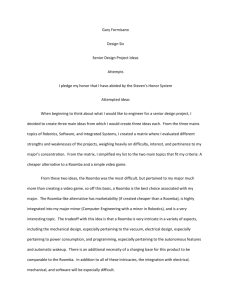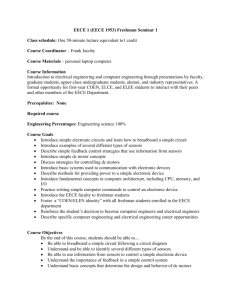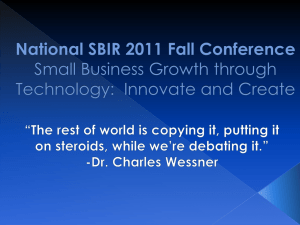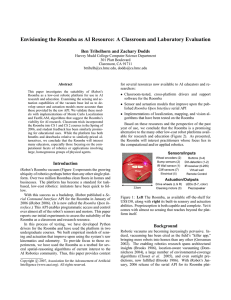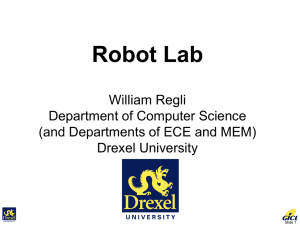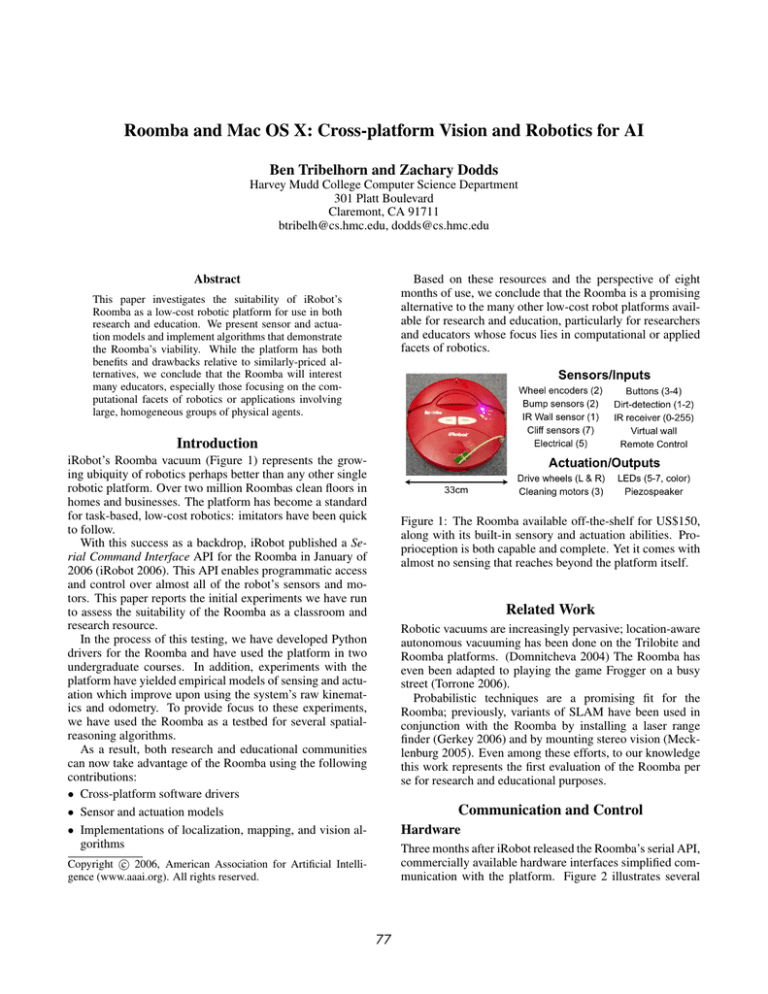
Roomba and Mac OS X: Cross-platform Vision and Robotics for AI
Ben Tribelhorn and Zachary Dodds
Harvey Mudd College Computer Science Department
301 Platt Boulevard
Claremont, CA 91711
btribelh@cs.hmc.edu, dodds@cs.hmc.edu
Abstract
Based on these resources and the perspective of eight
months of use, we conclude that the Roomba is a promising
alternative to the many other low-cost robot platforms available for research and education, particularly for researchers
and educators whose focus lies in computational or applied
facets of robotics.
This paper investigates the suitability of iRobot’s
Roomba as a low-cost robotic platform for use in both
research and education. We present sensor and actuation models and implement algorithms that demonstrate
the Roomba’s viability. While the platform has both
benefits and drawbacks relative to similarly-priced alternatives, we conclude that the Roomba will interest
many educators, especially those focusing on the computational facets of robotics or applications involving
large, homogeneous groups of physical agents.
Introduction
iRobot’s Roomba vacuum (Figure 1) represents the growing ubiquity of robotics perhaps better than any other single
robotic platform. Over two million Roombas clean floors in
homes and businesses. The platform has become a standard
for task-based, low-cost robotics: imitators have been quick
to follow.
With this success as a backdrop, iRobot published a Serial Command Interface API for the Roomba in January of
2006 (iRobot 2006). This API enables programmatic access
and control over almost all of the robot’s sensors and motors. This paper reports the initial experiments we have run
to assess the suitability of the Roomba as a classroom and
research resource.
In the process of this testing, we have developed Python
drivers for the Roomba and have used the platform in two
undergraduate courses. In addition, experiments with the
platform have yielded empirical models of sensing and actuation which improve upon using the system’s raw kinematics and odometry. To provide focus to these experiments,
we have used the Roomba as a testbed for several spatialreasoning algorithms.
As a result, both research and educational communities
can now take advantage of the Roomba using the following
contributions:
• Cross-platform software drivers
• Sensor and actuation models
• Implementations of localization, mapping, and vision algorithms
Figure 1: The Roomba available off-the-shelf for US$150,
along with its built-in sensory and actuation abilities. Proprioception is both capable and complete. Yet it comes with
almost no sensing that reaches beyond the platform itself.
Related Work
Robotic vacuums are increasingly pervasive; location-aware
autonomous vacuuming has been done on the Trilobite and
Roomba platforms. (Domnitcheva 2004) The Roomba has
even been adapted to playing the game Frogger on a busy
street (Torrone 2006).
Probabilistic techniques are a promising fit for the
Roomba; previously, variants of SLAM have been used in
conjunction with the Roomba by installing a laser range
finder (Gerkey 2006) and by mounting stereo vision (Mecklenburg 2005). Even among these efforts, to our knowledge
this work represents the first evaluation of the Roomba per
se for research and educational purposes.
Communication and Control
Hardware
Three months after iRobot released the Roomba’s serial API,
commercially available hardware interfaces simplified communication with the platform. Figure 2 illustrates several
c 2006, American Association for Artificial IntelliCopyright gence (www.aaai.org). All rights reserved.
77
Throughput
of the available connectors: USB, Bluetooth, and RS232
(RoombaDevTools 2006).
USB polling of the Roomba’s full suite of sensors averages a
throughput around 66Hz; Bluetooth is considerably slower.
A single RooTooth will only peak at 16Hz in Fast Data Mode
and 6Hz in its normal mode. A possible solution to this limit
in bandwidth would be to mount a micro-controller which
reacts to the sensors for stopping quickly and allows higher
level decisions to be made by a computer which would only
send and receive a less rich set of data. In this paper, however, we maintain focus on the capabilities of the unmodified
Roomba.
Figure 2: Commercially available USB, RS232, and Bluetooth serial interfaces to the Roomba provide researchers
and educators an inexpensive platform that requires no custom hardware or construction at all. When obtained with a
Roomba, these devices cost US $10, $5, and $80, respectively (RoombaDevTools 2006).
Simulation
Building atop these python drivers, James Snow has created an interface to the Roomba available within the Python
Robotics (Pyro) toolset. In addition, the Roomba is controllable via the player/stage simulator. Although both of these
resources provide a capable and sophisticated interface to all
of the hardware platforms they support, we used a simple,
homegrown simulator for the Roomba as a testbed for our
algorithm implementations. This Python 2D visualizer (depicted at right in Figure 6) can emulate the platform’s local
sensing and is packaged with the drivers.
The most flexible method of communication is Bluetooth,
which uses the unlicensed 2.4 GHz ISM (Industrial Scientific Medical) band. Figure 2’s Bluetooth device, nicknamed
the RooTooth is Class 1, allowing an optimal range of 100
meters. Connection quality over distance drops slowly and
our tests indicate that adequate connections can be made at
up to 200ft. The number of Bluetooth devices that, in theory,
can be used simultaneously is large, as there are 79 channels
available. Our tests have demonstrated that a single laptop
can easily interact with multiple devices; we tested 5 concurrently without a reduction in throughput to the individual
Roombas.
Modeling the Roomba
Odometry
Drivers
Figure 3: The architecture of our Python-based software
driver.
Figure 4: Regressions of translation and rotation yield m,
the robot’s lean for a specific Roomba, named R5. We created equations for odometric distance and angle from similar
analyses across several robots.
We have written two Python layers atop iRobot’s bytelevel API. The lower layer provides full access to the
Roomba’s sensors, speaker, motors, and built-in behaviors.
Our top layer allows for straight-line translation (oddly, not
part of iRobot’s provided API), and it includes our odometric correction model described in the following section. Figure 3 summarizes the software architecture; the code itself
is freely available at (Dodds & Tribelhorn 2006).
Roombas do provide odometry. Unfortunately, there is
a huge bias in translating left and right turning around the
maximum radius of curvature (ROC) (80◦ vs. −30◦ over
78
15s at 20cm/s). Our ”RoombaDrive” layer compensates for
this bias by enabling both simple rotation and straight-line
translation. Because the API does not provide straight-line
translation, it is achieved in software by time-slicing left and
right turns at the maximum ROC. This time-slicing parameter is denoted α.
Running several tests of our line driving and turning code
allowed us to extract a motion model. In Figure 4, data
from a single robot is depicted. Linear regressions of raw
data versus actual position in linear translation and rotation
shows that the slope m is constant between line driving and
turning. We ran the tests over multiple robots of different
batches and found this correlation to be consistent.
Equations for distance and angle (r, θ) as functions of the
robots’ raw data and the robot specific α become the following:
distance
r=
∗ (0.705 + α − α2 ) − 5
(1)
10.0
angle
∗ (0.705 + α − α2 )
(2)
θ=
129.0
The bump sensors have four states which result from a left
and right sensor attached to a rigid bumper. These states are
left, right, front, or no bump. The collision angle that will
produce a front bump varies with the sampling rate. For an
ideal situation, bumps within the cone of ±20◦ cause both
sensors to trigger (due to bumper rigidity). However at sampling rates of around 4Hz or less, a front bump will be detected at a range of ±60◦ or more. If the response to this
bump is similarly slow, the robot will usually slip and actually end its motion facing the wall which can adversely
effect odometry. Our modeled odometry, however, does not
suffer as much as the uncorrected odometry.
The virtual wall is difficult to use for MCL and other algorithms as a single wall of many because the uncertainty
of hitting the cone of the virtual wall is rather large especially compared to the ground truth of a physical wall bump.
Rather than model the virtual wall explicitly, however, the
algorithms that follow simply incorporated additional uncertainty into their probabilistic motion models.
Algorithmic Validation: MCL
Monte Carlo Localization (MCL) is a probabilistic estimation of pose in a known map that combines range sensing
and odometry. Using only the local sensing of the Roomba
we were able to implement and demonstrate successful pose
tracking at AAAI 2006. An example of a successful MCL
run is shown in Figure 6.
Figure 5: Comparison of basic kinematic odometry, velocity estimated odometry, and our modeled odometry on two
robots from separate batches. For this sample N = 18.
Results from testing of our motion model against basic
odometry and velocity-based odometry are illustrated in Figure 5. The sampled error for naive odometry is σr = 11.5%
and σθ = 12.4% which depends strongly on the specific
robot. Integrating the commanded velocities to estimate position results in even more significant errors, as shown. Our
corrected model has error of σr = 2.9% and σθ = 6.1%,
which significantly improves odometric accuracy.
Local Sensing
Figure 6: Recorded at AAAI 2006, this shows a Roomba
successfully localizing itself using MCL. In the middle image note that the wall in question is actually a virtual wall,
encountered as an observer paused to watch the action.
The Roomba has only local sensing in the form of bump and
IR sensors. When the Roomba bumps it will regularly slip as
it pushes forward and this causes the robot to rotate. This rotation is not measured by the odometry and as such must be
compensated by increasing error within the software. The IR
sensors can detect virtual walls (provided with the Roomba)
and cliffs.
Our video recorded at AAAI and initial runs used the following model of uniform error in motion: 35% in distance
79
Figure 7: A successful in lab run of MCL where the most
probable pose (blue dot) was identical to the ground truth
pose.
and 25% in angle which compensated for the inaccuracy
of the naive kinematic model. Recall that when driving in
large arcs the Roomba’s actual motion deviates substantially
from its odometric readings. Thus, these large uniform errors were necessary to create a sufficiently robust cloud of
particles for MCL. We used 300 particles to successfully localize the Roomba.
Straight-line translation, in general, is more useful than
this arc-based motion model both for pedagogical reasons
(specifying line segments to travel is a natural starting point
for robot programming) and because of the reductions in
odometric uncertainty shown in Figure 5. Thus, it was with
this improvement to the raw, API-provided driving ability
that we sought to implement mapping on the Roomba. We
did this in two ways. The first was by adding vision to
the system’s capabilities through an onboard laptop and an
attached webcamera. The second approach used only the
built-in bump sensor along with strong assumptions about
the Roomba’s environment.
Figure 8: Mounting a laptop and the iSight on the Roomba.
quired:
Y = ((66R + 129G + 25B + 128) >> 8) + 16
U = ((−38R − 74G + 112B + 128) >> 8) + 128
V = ((112R − 94G − 18B + 128) >> 8) + 128
Using Mac OS X as this project’s primary development
environment, we have devloped a C library that enables access to the pixel values provided by the iSight camera (or
any other QuickTime input). Prior work in this area has not
allowed for pixel-level access of values (Heckenberg 2003).
We implemented a set of vision algorithms that find the
largest connected components segmented by color and calculates a set of shape statistics on that object which are used
for classification. For example, segmentation on “red” will
match the teddy bear’s clothing. The data on the segmented
object is in Table 1. Additional information such as the centroid is not listed. These shape statistics are very useful in
identifying objects of the same or similar color. Consider
that a cone would have a measured angle near vertical while
a red strip on the wall would be horizontal. It is also easy to
use the pixel count to eliminate noise by enforcing a minimum size before classifying an object.
The information that this method provides is a good starting point for more complex online algorithms. In many
cases this data analysis is sufficient for discerning a small
set of known objects.
Adding Vision
Mapping is a logical algorithm to try after localization, but
the most popular mapping algorithms today require richer
sensing than the Roomba provides. We chose to mount a laptop on the Roomba with velcro to attain onboard processing
for vision processing. This setup with Apple’s iSight camera
can be seen in Figure 8.
Using the iSight, we discovered that the iSight provides
pixels in YUV 4:2:2 natively. YUV space is not an absolute
color space; it is only a lossy encoding of RGB data. The
actual data is 16 bits per pixel providing either a set of UY
or VY values for that pixel. This loss in color information is
generally undetectable by the human eye because our eyes
are more sensitive to the luminance (Y) than differences in
color (UV). Initially we converted the YUV values to RGB,
but color segmentation does not improve with RGB thresholding. Thus, to save on computation we reverted to using
the raw YUV values. However, for human interaction, e.g.,
drawing atop the image, YUV/RGB conversion is still re-
FastSLAM
We implemented FastSLAM 1.0 with known data correspondence as detailed in Probabilistic Robotics (Thrun, Burgard, & Fox 2005). FastSLAM uses a point-feature tracker,
80
Shape Statistic
ellipse angle
major axis
minor axis
pixel count
roundness
color
Value
23.1◦
76.5
45.5
1918
0.42
“red”
Table 1: Shape statistic values for finding the bear.
Figure 10: The final position of the Roomba when it closes
the loop.
These assumptions allow several interpretations of the incoming data, e.g., line fitting to raw odometry of the bumps.
Our results from this algorithm and others are presented in
(Tribelhorn & Dodds 2007).
Educational Trials
The Roomba was used as the basis for several assignments
in a CS1/CS2 course sequence taught at Chatham College,
an all-women’s institution in Pittsburgh, PA. Low cost was
one reason for choosing the Roomba. The more compelling
reason, however, was that the Roomba, as a simple serial
peripheral, integrated effortlessly into the environment in
which these courses were already being taught.
This CS1/CS2 trial included an external assessment effort
to determine the extent to which the Roomba (and robots in
general) affected students’ feelings and capabilities in learning introductory computer science. The results have shown
that the physical interactions had a significant impact. One
student indicated that the impact was intellectual:
Like when you’re just working on the screen it’s like
‘oh the little dot is moving.’ When you’re working with
the actual thing [the Roomba], you’re like okay, problem solving. Because it’s a lot easier to solve the problem if it’s 3D, in front of you, and you can see exactly
what the problem is.
Another student described the robot’s impact in affective
terms: “Playing with the Roomba made it a lot more fun.”
A third student pointed to overcoming some of the
Roomba’s idiosyncracies when asked Which activities do
you think have been most useful this semester in making you
a better programmer?:
I would say that probably working with the Roomba
definitely just because the first day we worked with it
we were trying to get it to go in a straight line because
it has like a natural curve to it so it doesn’t go straight.
Overall, the Roomba added excitement to the classes, and
it provided hands-on, task-specific applications for the programming concepts covered. Moreover, the Roomba did not
Figure 9: The largest connected component of teddy bear tshirt red is colored in blue. The shape statistics are listed in
Table 1.
so vision is a natural fit. We created visual landmarks by
placing construction paper on the walls as seen in Figure 10.
In a joysticked run of the robot, the vision system correctly
identified and plotted the uncertainty of the four landmarks
as shown in Figure 11. The loop closure that occurs when
the red landmark is seen for a second time significantly reduces that feature’s pose uncertainty.
Bump-only Roomba Mapping
Mapping without vision on the Roomba presents a stiff challenge because of the platform’s lack of built-in range sensing. We have designed a preliminary set of mapping algorithms using only local bump sensing and odometry. To
compensate for this impoverished sensory data, we assume
strong prior knowledge about the environment:
• that it consists only of straight-line walls.
• that all of those wall segments are either parallel or perpendicular.
81
Platform
Lego RCX
Roomba
Lego NXT
Intellibrain
PalmPRK
HandyBoard
KIPR XBC
UMN eRosi
HandyBoard2
Hemisson
Garcia
Khepera
AIBO
Cost
$200
$230
$250
$300
$325
$350
$500
$500
$750
$780
$1725
$2000
$2000
Sensing
Bmp,Lt
Vis,Mic,Bmp,Enc,WL
Bmp,Lt,Son,Enc,WL
Bmp,Lt,IR,a2d,WL
IR,a2d
Bmp,Lt,IR,a2d
Vis,Bmp,Lt,IR,Enc
Lt,Enc,Pyr,WL
Vis,Bmp,Lt,IR,Enc,a2d,WL
Lt,IR,WL
Vis,IR,Enc,WL
IR,Enc
Vis,Mic,Bmp,Enc,WL
Figure 12: A comparison of several inexpensive robot platforms/controllers, their costs, and their standard set of sensing capabilities. Legend: Bmp, bump or tactile sensing;
Lt, light sensing; Vis, vision; Mic, microphone; Enc, encoders or odometry; WL, wireless communication with a
controlling PC; a2d, general analog/digital inputs; IR, infrared range sensing; Pyr, heat or flame sensing;
Figure 11: A closed loop run of vision-based FastSLAM.
for handling its idiosyncrasies, and and an initial assessment
of the Roomba’s capabilities. We believe it won’t be long
before there emerge a wide variety of applications of this
modest platform.
add the time-intensive overhead of constructing and maintaining Lego-based or other hand-built platforms, nor did it
require us to change the programming language or OS on
which the class was based. In contrast to many of the other
platforms in Figure 12, the Roomba can be used to support
an existing CS and AI curriculum, rather than requiring a
curriculum designed especially for it.
Acknowledgments
This work was made possible by funds from NSF DUE
#0536173, as well as funding and resources from Harvey
Mudd College and Chatham College.
Perspective
References
These extensions and applications of the Roomba only
scratch the surface of what is possible, enabling users an
inexpensive basis on which to design systems that run “with
our initiation, but without our intervention.” (Brooks 1986)
As this paper demonstrates, even the ubiquitous, unmodified
Roomba platform can support far more than the vacuuming
tasks for which it was designed. As an educational resource,
the Roomba is pedagogically scalable: it is as suitable for
reinforcing beginning programming concepts as it is for exploring algorithms of current interest to the robotics community. As a research resource, the Roomba empowers investigators who want to use robots, rather than build them. For
example, it offers researchers involved in the fields of multiagent systems, HRI, or many other subfields of AI and CS an
off-the-shelf means to embody and test their work without
having to spend time constructing or modifying hardware.
Ultimately, the Roomba offers the robotics community
both an example of the widespread commercial viability of
autonomous robots and a novel resource we can leverage
toward our educational and research goals. It heralds the
advent of robotic peripherals that can take advantage of all
of the computing power and cost-efficiency of today’s commodity laptop and desktop machines. This paper provides an
improved odometric model of the Roomba, some strategies
Brooks, R. 1986. Achieving Artificial Intelligence through Building Robots. Technical report, Massachusetts Institute of Technology, Cambridge, MA, AI-Memo 899.
Dodds, Z., and Tribelhorn, B.
2006.
Erdos.
http://www.cs.hmc.edu/∼dodds/erdos.
Domnitcheva, S. 2004. Smart vacuum cleaner - an autonomous
location-aware cleaning device.
Gerkey, B.
2006.
Mapping with the iRobot Roomba.
http://www.ai.sri.com/∼gerkey/roomba/index.html.
Heckenberg, D. 2003. Using Mac OS X for Real-Time Image
Processing. In Proceedings of the Apple University Consortium
Conference.
2006. Roomba SCI specification. www.irobot.com/hacker.
Mecklenburg,
P.
2005.
Roomba SLAM.
http://www.cs.unc.edu/∼prm/roomba/roomba-slam.pdf.
2006. RoombaDevTools. www.roombadevtools.com.
Thrun, S.; Burgard, W.; and Fox, D. 2005. Probabilistic Robotics.
MIT Press.
Torrone, P. 2006. Roomba Tronic. Make Magazine Volume 06:
Robots.
Tribelhorn, B., and Dodds, Z. 2007. Evaluating the Roomba: A
low-cost, ubiquitous platform for robotics research and education.
Submission to ICRA 2007.
82

